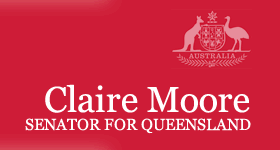Claire Moore (Queensland) 7.03pm
One of North Stradbroke Island's well-known Indigenous women, Estelle Bertossi, was farewelled on Wednesday after a life dedicated to change for her community. Estelle was born on the Cherbourg Mission in 1929 and died at Dunwich, North Stradbroke Island, Minjerriba, in 2010. Her grandmother was a Darambal woman from what is now Gracemere, outside Rockhampton in Central Queensland, whose family was forcibly removed to Cherbourg.
In the mid-1930s, Estelle was moved with her mother from Cherbourg to the Myora Mission on North Stradbroke Island, which was run at the time by the Salvation Army. The Myora Mission was established in 1892 and was a place of confinement for the Quandamooka people of Stradbroke and Moreton Islands and people relocated from the mainland. This mission closed in 1942 and people were moved to One Mile, which is now Dunwich.
Life at Myora was sparse; houses were unlined, water was from wells and there were pit latrines. An oyster reserve worked by people from the mission supplemented food supplies. The provisional school on the mission was abandoned in the mid-1930s and Estelle, as a young woman, attended the Dunwich school that provided classes up to grade 4. She also moved closer to Dunwich, living in a shed and then a cottage built behind the dairy.
Many Indigenous people, including those from the Myora Mission, were employees of the Dunwich Benevolent Asylum. This asylum run by the Queensland government dominated Dunwich. It opened in 1865 and closed in 1946. It was for non-Indigenous people from throughout the state-the sick, infirm, indigent, disabled and people suffering from alcohol abuse. In the 1930s, it had around 1,000 inmates in 20 wards for men, four wards for women and a tuberculosis ward. Indigenous women and men did the hard, dirty and domestic work at the asylum. They were paid rations and a little money. There were a series of efforts, including a strike in 1935, to get off the rations systems and receive full and proper wages. These efforts were successful in 1944, just two years before the closure of the asylum.
Estelle was returned to the Cherbourg Mission when her stepfather was relocated ostensibly because of drinking. She remained there into her teens. Anyone who knows life at Cherbourg knows that it was exceptionally hard with very little food and Estelle was worse off than were the children in the Cherbourg Mission dormitories. When Estelle was 14 years old, the family was moved again and Estelle was given permission-as she needed to have at that time-to return to Stradbroke which she obviously loved.
In 1945, Estelle went to work as a seamstress in Penney's Building, Queen Street, Brisbane, which is still there. She lodged for a couple of years with Oodgeroo Noonuccal, Kath Walker. They also shared a strong political sense and took action. Estelle campaigned alongside Oodgeroo in the referendum of 1967.
Estelle's involvement with the ALP continued from the 1960s and she was awarded a well-deserved life membership of our party in the 2000s. This was richly deserved and responded to her years of commitment to achieving social justice.
Estelle married Hector Bertossi in 1956 and they had four children; Les junior, Anthony, Lisa and Peter. Hector was an Italian refugee and a World War II survivor who worked cutting sugar cane by hand and later as a miner in Mount Isa and then in sandmining on North Stradbroke Island. Hector and Estelle built a house at Dunwich and Estelle worked cleaning staff houses in Dunwich. Later, when the mining companies eventually employed women-and it took a long time for that to occur-she worked full-time for more than fifteen years in the mineral laboratory at Consolidated Rutile Ltd.
Estelle committed herself to the Indigenous and non-Indigenous community on Stradbroke. She worked tirelessly to secure Aboriginal housing and also for a real medical centre and for aged care facilities. She helped to get housing for very many families on the island. She was a natural fighter for social justice and she challenged many government policies. This involved being involved in many organisations and committees: she was a founding member of the North Stradbroke Island Aboriginal Housing Cooperative, later being made a life member. She was a committee member of the Yulu-Burri-Ba Community Health Centre, and with the Minjerribah Moorgumpin Elders.
With Hector, she worked with the Surf Life Saving nippers and joined the Stradbroke Island Management Organisation-SIMO-in its campaign against a road bridge to the island. That was a long-standing and very tough campaign. She also worked for better environmental protection. She was a volunteer with the North Stradbroke Island Museum from its formation in 1987, and saw it develop as a place that celebrates the Indigenous and non-Indigenous history of the island which then won a national award in 2009.
Estelle was woman of love, peace and reconciliation. She was an entirely unselfish woman, and was prepared to be friends with everyone despite the real harshness of her treatment as a child. In 2009, the Redland City Council recognised her as one of 10 inspiring seniors who had made a significant contribution to the local community. Her portrait was printed on bookmarks distributed through local libraries with her proudly printed words-and many people who knew Estelle knew that these words actually represented so much of her life-'Do the best you can and people will show you the way.'
Estelle worked hard for her community. She worked hard for a true sense of reconciliation. The work that was done on Stradbroke Island over the period to build knowledge and awareness of Indigenous culture and to make links with the young people through schools and also through the local community was a real passion for Estelle. Many people loved her sense of community and also her sense of true commitment. She will be truly missed. She had a strong and worthy life and everybody knows that the difference she made means that Estelle will be a long-term memory for the community around Stradbroke Island.
I want to also acknowledge her family, who were able to talk about Estelle and also provided the words for this evening. My good friend Howard Guille, with whom Estelle had many long discussions, was also very helpful in preparing these memories about Estelle.
We need women like Aunty Estelle because she made a genuine difference not only to her own life and family but to all of us. It makes me very proud to be able to say that we are giving worthy tribute to Ms Estelle Bertossi.




